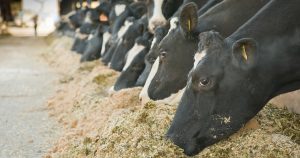Low-lignin alfalfa and BMR corn silage offer significant advantages to dairy farmers who want to capitalize on home-grown feeds and keep more cash at home.
 More fiber in the dairy diet means less space in the rumen, but intakes can be bolstered with lower fiber, higher digestibility feeds, Dr. David Combs, University of Wisconsin Madison dairy nutrition expert, said during the January “World Class Webinar” presented by Professional Dairy Producers of Wisconsin.
More fiber in the dairy diet means less space in the rumen, but intakes can be bolstered with lower fiber, higher digestibility feeds, Dr. David Combs, University of Wisconsin Madison dairy nutrition expert, said during the January “World Class Webinar” presented by Professional Dairy Producers of Wisconsin.
Not all forages are the same. NDF digestibility can swing from 30-50 percent, which can swing milk production by 8-10 pounds, while swings in starch digestibility can swing milk production by 4-6 pounds.
Studies show improving fiber digestibility can significantly increase dry matter intake for a substantial bump in milk yield. “A 2-3 unit change in diet digestibility by feeding higher quality forages corresponds to an extra pound of milk, so it’s very important to get higher digestibility forages in the diet,” Combs said.
Both low-lignin alfalfa and BMR corn silage have higher fiber digestibility than their conventional counterparts
BMR vs. conventional corn silage
Evaluation studies show the fiber digestibility of BMR corn silage consistently runs 3-4 units higher than conventional corn silage, a reflection of the BMR trait.
In the open field, however, growing conditions can grate against the genetics. There is overlap, with some conventional corn testing high on fiber digestibility and some BMR corn testing low.
On average, however, BMR corn tests higher. “The BMRs with superior genetic traits consistently improve feed digestibility, but the environment has an overriding effect,” Combs noted.
Studies show days in milk (DMI) and milk yields are greater when BMR and high fiber digestibility (HFD crops) are fed. “The data shows BMR and HFD lines had significantly higher intakes and, as a result, more milk production,” Combs reported.
Fat test and protein tests weren’t really affected by feed digestibility. “Don’t expect negative impacts from feeding BMR corn silage and low-lignin lines,” he said.
Reduced lignin alfalfa
Currently, there are two reduced lignin alfalfa varieties on the market. HiGest, a natural selection from Alforex , was introduced three years ago, followed the next year by HarvXtra, a GMO crop from Forage Genetics International.
As lignin accumulates in the plant cell wall, hemicellulose (HC) digestibility decreases. “The concept is reducing the lignin in the cell wall leaves the HC more digestible,” Combs explained.
However, lignin is important for plant health. It provides strength to the plant, important for lodging resistance, and allows the plant’s vascular system to transport water, important for drought-resistance. It also decomposes very slowly, which contributes to soil quality.
Utilizing the benefits
As a farmer waits to harvest alfalfa, yields will climb, but quality declines. “The challenge is trying to harvest in the sweet spot where yield and quality is optimized,” Combs said. “What’s exciting is low-lignin lines add lignin more slowly.”
That opens two strategies. One is to cut low-lignin alfalfa at the normal intervals and reap higher feed digestibility and quality.
The other is harvesting less frequently, and still maintain quality. “This strategy is a significant benefit of growing low-lignin alfalfa,” Combs said.
Cutting can be delayed 7-10 days, depending on the variety, to capture an extra week of growth and yield. “That’s what low-lignin alfalfa brings to the table – a wider harvest window,” he pointed out. “The later harvest gives a greater tonnage per cutting and lets farmers make use of the full growing season.”
A six state study including Wisconsin, conducted in 2016, found the longer cutting interval pushed yields of HarvXtra by a half-ton per acre higher in the seedling year.
There is a yield drag with HarvXtra, as there is with BMR corn, but yields rise with the delayed cutting plan.
HarvXtra had significantly higher feed digestibility compared to the trial’s conventional varieties, regardless of maturity. During the 10 day delay in harvest, fiber and lignin accumulated more slowly in low-lignin alfalfa, Combs explained.
When HiGest is compared to HarvXtra by reviewing feed quality measurements over six sampling dates, NDF, NDFD and RFQ were similar and all favorable over conventional varieties. “Rankings were fairly consistent and ranked out higher than conventional varieties of alfalfa,” Combs reported.
Another study pushing fiber digestibility to high levels showed improved feed digestibility has a nice milk production response, no change on fat test and very little on protein.
“The bottom line with fiber digestibility is anything we can do to improve it is going to support milk production,” Combs said.
Source: Wisconsin Farmer




